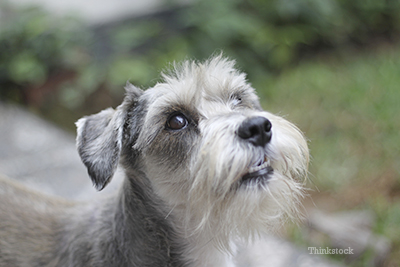

Over the years I’ve developed a top ten list of my most despised diseases. Those that make this list tend to be diseases that are untreatable, leaving me helpless to fix my patient. Such is the case with Sudden Acquired Retinal Degeneration Syndrome (aka, SARDS). In addition to being untreatable, the cause of SARDS is unknown. (Note to reader: the less that is known about a disease, the longer the name of that disease.)
What we do know about SARDS in dogs
SARDS is a middle age disease in dogs, and approximately 60% of affected dogs are females. Any breed is susceptible, but Dachshunds, Miniature Schnauzers, Pugs, Brittany Spaniels, Malteses, Bichon Frises, and mixed-breed dogs are particularly predisposed.
SARDS affects the thin-layered retinas which receive visual input and then transport this information to the brain via the optic nerve. In dogs with SARDS, the photoreceptors (rods and cones) and possibly the nerve fiber layers within the retinas undergo degenerative changes. The end result is complete blindness. These changes are microscopic in nature—one cannot detect them by performing a basic eye exam. Therefore, the diagnosis of SARDS is made based on the patient’s history, the presence of partial to complete blindness in both eyes, normal appearing retinas, and characteristic changes on an electroretinogram (ERG). The ERG is a test used to evaluate photoreceptor function and is performed by veterinarians who are specialists in ophthalmology .
It’s been theorized that SARDS is an autoimmune disease in which a misbehaving immune system attacks the body’s own normal cells. However, dogs with SARDS who have received immunosuppressive therapy (the treatment of choice for autoimmune diseases) have not demonstrated any clear improvement in overall outcome compared to untreated dogs.
Symptoms of SARDS in dogs
All dogs with SARDS develop:
- Complete and permanent blindness over a rapid course (typically days to weeks)
- Stumbling
- Difficulty navigating at night
- A failure to track treats
During the weeks and months preceding their blindness, most SARDS-affected dogs also experience marked increases in appetite and/or thirst with subsequent weight gain and changes in urinary behavior.
Diagnosing SARDS in dogs
Testing for hormonal imbalances (diabetes mellitus, Cushing’s disease) that classically cause these symptoms is commonly pursued and typically comes up empty. Savvy veterinarians consider the possibility of SARDS before loss of vision becomes apparent. In most cases, it is not until vision wanes that the diagnosis of SARDS becomes suspect.
Long-term outcomes for SARDS affected dogs and their human companions
When a dog develops SARDS, a significant period of adjustment is required for everyone involved. Imagine living with a newly blind dog who is begging for food, drinking incessantly, and urinating copious amounts (all of that water has to go somewhere).
A study, published in the Journal of the American Veterinary Medical Association, of long-term outcomes in dogs with SARDS surveyed 100 people living with SARDS-affected dogs. In addition to blindness, most of the dogs were reported to have increased thirst, urine output, and appetite along with weight gain. Increased appetite was the only one of these symptoms reported to increase over the course of one year following the SARDS diagnosis.
In this study, 22 of the 100 dogs received some sort of treatment (corticosteroids, nutritional supplements, melatonin and/or doxycycline) for their blindness. None experienced improved vision in response to therapy.
Eighty-seven percent of the dogs were reported to have moderate to excellent navigation skills within their home environments, and 81% had moderate to excellent navigation skills within their yard environments. Of the people surveyed, 28% reported making special provisions for their dogs such as the use of baby gates, fencing, and ramps, carpeting pathways to important locations, and auditory clues or scents to signify certain locations.
Thirty-seven percent of respondents reported that the relationship with their dog actually improved after the SARDS diagnosis. The authors of the study theorized that the increased time and involvement necessary to care for a blind dog may have been responsible for enhancing the human-animal connection. Only 17% reported that the relationship with their dog worsened.
Seventy-six percent of respondents ranked the quality of their dog’s life to be moderate to excellent. Only nine dogs were reported to have a poor quality of life. Of the 100 people surveyed, 95 indicated that they would discourage euthanasia if advising others caring for dogs with SARDS.
This study provides truly uplifting results. While adaptation to a dog’s loss of vision usually proceeds smoothly, factor in the other SARDS symptoms and the challenge to maintain quality of life for everyone involved increases significantly. Dogs and the people who love them can be amazingly adaptive creatures!
Questions to ask your veterinarian:
- What can I do to help my dog adapt to his blindness?
- What are some tips for keeping my dog safe now that he is blind?
- How will I be able to know if my dog’s quality of life remains good?
- Can we stay in communication to discuss symptoms over the next few months?
If you have any questions or concerns, you should always visit or call your veterinarian -- they are your best resource to ensure the health and well-being of your pets.
